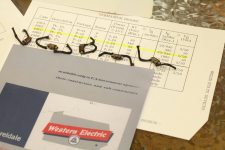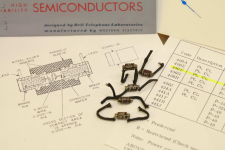Hello everyone,
I have a diode question, this is not a sales post... just here to ask opinions.
The below diodes, near as I can tell are really interesting alternatives to IN34's
When I came into a quantity (hundreds!) of super cool. super early Germanium diodes (historical point contact too) , that were well spec'd and ridulously overbuilt.. I thought, "now here's the coolest thing I've ever seen to build or retrofit a pedal around."
The thing I can't understand is.. if you are DiY'ong something.. why use boring, cheap or "reissue / common germanium types" just because they cost $1 and maybe sound OK? Wouldn't it be cooler to use something historical? sure.. maybe these have slightly different behavior .. so do a circuit just for them... or find what they do sub (I think an IN34 may be a good target to replace).... compared to the super cheap 0.30 cent IN34's most builders choose... I would expect these to:
I don't know.. these are old.. they are tiny.. but still huge compared to modern stuff. They are begging for a boutique effect.
And they have really overdone materials inside. Western Electric was Bell Labs, and they were Aerospace and way over-engineered compared to consumer devices.. These are used.. and the ones I have tested on the scope work super well , and have the nice looking Germanium " shoulder or knee". These work a little bit "better" than regular diodes.. they are faster, but not too fast. And they are point-contact, a special type of early construction.
I have had no interest from pedal builders or DiY'ers.. I've even sent off a few samples...
Does anyone know why there is "component / experimenter malaise"? Why are we all just ordering the new, surplus , junk? Is it really than we are all just not willing to deviate a little for the "called for" component? That's not how fuzz happened
I have a diode question, this is not a sales post... just here to ask opinions.
The below diodes, near as I can tell are really interesting alternatives to IN34's
When I came into a quantity (hundreds!) of super cool. super early Germanium diodes (historical point contact too) , that were well spec'd and ridulously overbuilt.. I thought, "now here's the coolest thing I've ever seen to build or retrofit a pedal around."
The thing I can't understand is.. if you are DiY'ong something.. why use boring, cheap or "reissue / common germanium types" just because they cost $1 and maybe sound OK? Wouldn't it be cooler to use something historical? sure.. maybe these have slightly different behavior .. so do a circuit just for them... or find what they do sub (I think an IN34 may be a good target to replace).... compared to the super cheap 0.30 cent IN34's most builders choose... I would expect these to:
- posses a smoother, more refined clipping effect due to the higher forward voltage drop.
- Potentially warmer sound with more headroom and less aggressive distortion.
- better (or worse?) noise performance due to lower leakage current and extreme age.
I don't know.. these are old.. they are tiny.. but still huge compared to modern stuff. They are begging for a boutique effect.
And they have really overdone materials inside. Western Electric was Bell Labs, and they were Aerospace and way over-engineered compared to consumer devices.. These are used.. and the ones I have tested on the scope work super well , and have the nice looking Germanium " shoulder or knee". These work a little bit "better" than regular diodes.. they are faster, but not too fast. And they are point-contact, a special type of early construction.
I have had no interest from pedal builders or DiY'ers.. I've even sent off a few samples...
Does anyone know why there is "component / experimenter malaise"? Why are we all just ordering the new, surplus , junk? Is it really than we are all just not willing to deviate a little for the "called for" component? That's not how fuzz happened



